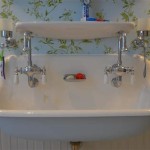How To Redo a Small Bathroom Floor
A small bathroom can feel cramped and cluttered, but a new floor can make a big difference. Replacing the floor in a small bathroom is a relatively straightforward project that can be accomplished with a few basic tools and some patience. This article will guide you through the process of redoinng a small bathroom floor, providing you with step-by-step instructions and tips for success.
Step 1: Preparation
Before you begin ripping up your old bathroom floor, there are a few preparations to be made. Start by clearing out the bathroom as much as possible. Remove all furniture, towels, and other items to ensure you have enough space to work. Next, you will need to turn off the water supply to the bathroom. Locate the shut-off valve for the bathroom plumbing and turn it off. Once the water is off, you can drain the pipes by turning on the faucets until all water has drained out.
Once you have cleared the bathroom and shut off the water supply, you will need to protect yourself from any potential hazards. Wear protective gear like goggles, gloves, and a facemask to protect yourself from dust and debris. The old flooring material will likely be covered in dust and may contain harmful materials, so it is best to wear appropriate safety equipment.
After you put on your safety gear, you will need to decide if you are going to remove the existing baseboards. You will need to remove them if the new floor is thicker than the old one. You can remove the baseboard with a pry bar and a hammer. If your new floor is going to be the same thickness or thinner, you can leave the baseboards in place.
Step 2: Removing the Old Floor
With the water shut off and safety precautions in place, you can begin removing the old floor. The method for removing the old floor will depend on the type of flooring. It is best to remove old flooring in sections. This will make it easier to dispose of the old flooring. If you have tile flooring, you will need to use a hammer and chisel. For linoleum or vinyl flooring, you can use a utility knife to score the floor and then peel it up.
Once you have removed the old floor, you will need to prepare the subfloor for the new flooring. You will likely have some remnants of the old adhesive on the subfloor. Use a scraper to remove as much of the old adhesive as possible. Remove any nails or staples from the subfloor. You may also find that the subfloor has some damaged areas. If there is any damage, you will need to repair it before installing your new floor.
Step 3: Installing the New Floor
With the subfloor ready, you can begin installing the new floor. Be sure to choose a flooring material that is suitable for a bathroom. Some popular options include ceramic tile, porcelain tile, vinyl tile, and laminate flooring. Ceramic and porcelain tile are durable and water-resistant, making them excellent choices for bathrooms. Vinyl tile and laminate flooring are more affordable and offer a wide range of styles.
If installing a new floor over an existing subfloor, you will need to apply a moisture barrier. This will help to prevent moisture from damaging the new floor. You can purchase a moisture barrier at most home improvement stores. This moisture barrier should be applied to the subfloor before installing the new floor. It is essential that the moisture barrier is applied to the subfloor before installing the new flooring.
When installing the new floor tiles, begin in a corner of the bathroom. Ensure that the first tile is placed level and straight. Work your way across the bathroom, ensuring that tiles are properly spaced and aligned. Place spacers between your tiles to maintain the proper spacing. You will have to trim the last row of tiles to fit. If you are using tile, you will need to use grout to fill in the spaces between the tiles. Grout is a mixture of cement, sand, and water that hardens to create a waterproof seal.
Once the new floor is installed, you will need to allow it to cure for at least 24 hours before using the bathroom. This will ensure that the adhesive and grout have time to harden properly. Once the floor is cured, you can reattach your baseboards and replace your bathroom fixtures.
By following these steps, you can successfully replace your bathroom floor. Doing so will give your small bathroom a fresh new look and increase its value.

Bathroom Remodeling A Step By Guide Budget Dumpster
:max_bytes(150000):strip_icc()/beautiful-bathroom-wood-hexagon-floor-via-smallspaces.about.com-56f5b4273df78c78418a0e1b.jpg?strip=all)
17 Ways To Beautify A Small Bathroom Without Remodeling

7 Pretty Bathroom Floor Tile Ideas To Pin Even If You Re Not Remodeling Hunker Tiles Small Remodel Interior Design

9 Affordable Ideas For A Small Bathroom Remodel
How To Handle Your Small Bathroom Remodel Pods Blog

20 Beautiful Bathroom Flooring Ideas And Designs In 2024 Remodel Makeover Small

Bathroom Remodeling A Step By Guide Budget Dumpster

Small Bathroom Remodel In 5 Steps Retro Renovation

Understanding Small Bathroom Remodel Costs And How To Save

Small Bathroom Remodel Designs For Contemporary Lifestyles
Related Posts







